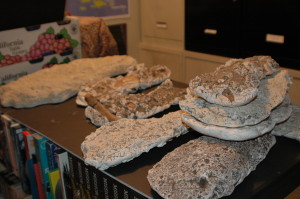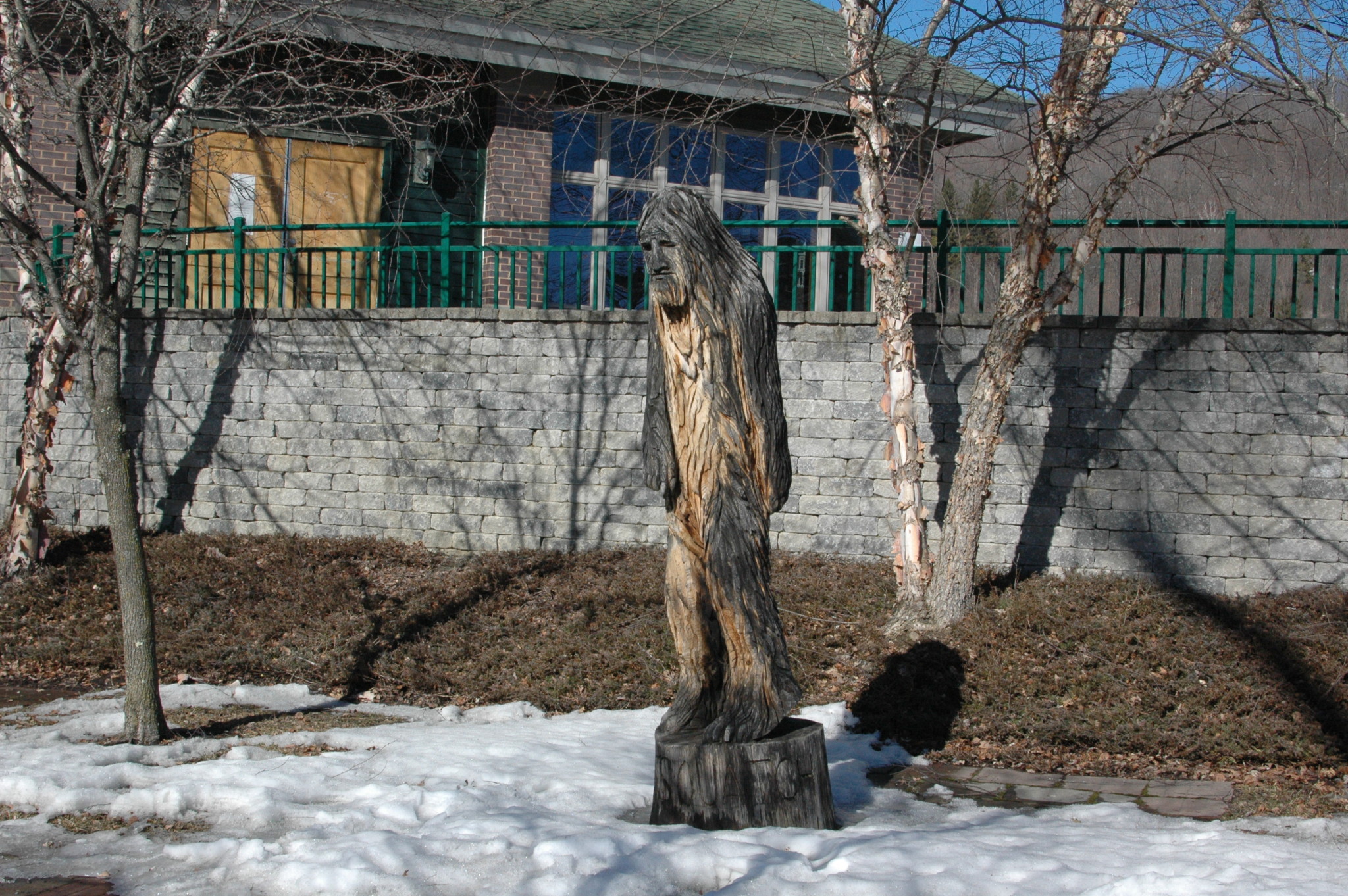By Dan King
It’s been 40 years since the first reported Sasquatch sighting in Whitehall and now the quest to find the creature has been reenergized.
Unlike 1975, this time around, the quest will include television cameras and crews hoping to reap the reward of finding one of the most heralded mythical creatures in the world.
Crew’s from Animal Planet’s “Finding Bigfoot” will be filming in Whitehall, in an attempt to produce yet another piece about the history of Sasquatch sightings in this town.
Joe James, the show’s producer, said he was intrigued by Whitehall’s history with the cr eature and the fact that “Whitehall seems to exist on the fringe…”
eature and the fact that “Whitehall seems to exist on the fringe…”
He said initially he had received many responses from interested witnesses, but many have passed away or have not responded to contact attempts, which he saw as a minor speed bump, but not one that will stop the crew from filming in town.
The crew is expected to arrive in Whitehall at some point next week to screen its options, but chooses to keep the details on the down low, to avoid false reports and “disturbances.”
The crew will eventually decide on a date and place for a “town hall” style meeting, which will be held prior to the crews going out and searching for the creature.
James said he hopes to hear a good variety of sighting stories, so the crew can get a clue of where to go when they begin shooting.
With the filming crews making their way to town in the coming weeks, Sasquatch sightings may once again become prominent in Whitehall.
Area History
It’s well documented that the North Country is one of the typical “hotspots” for Sasquatch sightings and the quest to find the creature, and reports go back centuries.
“This is not a new phenomenon,” said Paul Bartholomew, an area Bigfoot historian. “These sightings are  very consistent, dating back to the Iroquois and Algonquin.”
very consistent, dating back to the Iroquois and Algonquin.”
“Reports of these creatures can be traced back to the Iroquois and Algonquins,” a Whitehall law protecting the creature reads. “And are clearly referenced in the works of Samuel de Champlain and represent consistent patterns of sightings.”
De Champlain, a famous explorer of the new world, commonly referred to as the “Father of New France,” reportedly documented Sasquatch sightings as early as 1603. By many, his reports are considered the earliest documented sightings of Sasquatch in the North Country.
His reports came from stories that he was told by Native Americans, of a creature they called “Stone Giant” or “Hairy Wildman.”
There are also several reports of a similar creature dated in the 1700s, including those from famous American Revolution soldier Robert Rogers. In Rogers’ report, his rangers were chased from the woods by the unidentified creature.
Sightings Increase
Despite the early reports, it wasn’t until the 20th Century, particularly the 1970s, that Sasquatch sightings became a widespread phenomenon.
There have been a slew of witnesses around Northeastern New York, but no town has drawn more Sasquatch notoriety than the Birthplace of the U.S. Navy, Whitehall.
Some witnesses have passed away, some are still alive, but the fact that there have been multiple reports  in Whitehall, keeps many on the quest to find the creature.
in Whitehall, keeps many on the quest to find the creature.
The year was 1975, when the first reported sighting of Sasquatch in Whitehall took place.
Cliff Starks, who reportedly saw Sasquatch on the golf course, passed away a few years ago. When he passed away, he was honored by various different Sasquatch websites and societies, as one of the integral witnesses.
Abair Road Sightings
However, it was the sightings in 1976 that cemented Whitehall as a Mecca of Sasquatch sightings.
In August of 1976, Paul Gosselin, who at the time was 18-years-old, was out driving around with a friend, Marty Paddock. The two were driving down Abair Road, in the Town of Hampton, when they heard a female screaming.
Gosselin and Paddock glanced out into the vast field to see what the noise was coming from. The two reported to see a large, ape-like creature between 7-feet and 8-feet tall, darting toward their car.
Immediately, they both got in the car and stormed into the Village of Whitehall to report what they saw to police.
Gosselin’s brother, Brian, was the on duty police officer in the Village of Whitehall that night, when his father, brother and Paddock came flying back into the village.
“They were so strung out with excitement and fear,” he said.
The following night was Gosselin’s night off from work, so he decided to go out and see for himself.
Gosselin was down in the meadows, where his father and brother had seen the creature, while a state trooper was up at the top of the hill on Abair Road. The two were communicating via radio.
After about an hour and a half, Gosselin was radioed by the state trooper who said “Brian, what the  (expletive) is that. I’m heading out of here.”
(expletive) is that. I’m heading out of here.”
The trooper sped away, leaving Gosselin alone.
He said he continued to hear noises, “not twigs snapping, limbs snapping,” and something suddenly made him decide to turn his spot light in the direction of the sound.
“I turned my spotlight on it and it was now about 30-35 feet away,” Gosselin recalled. “It was over 7-feet tall, probably around 400 pounds. When I put the spotlight on it, it raised its hands, they weren’t paws, they were hands, I could see the fingers, to cover its eyes. They were red and about the diameter of a mayonnaise cover, they didn’t glow like a deer’s eyes in headlights though.”
Gosselin said at that moment he had a million different thoughts run through his head, when suddenly the creature turned and retreated, making a lengthy guttural noise.
“It’s impossible for a human to make that noise,” he said. “This thing showed no aggression though. If it wanted me it could have had me, let’s put it that way.”
Gosselin sat in the field for about 15 more minutes, trying to figure out what he had just encountered.
“I knew everything it wasn’t, it wasn’t a man, it wasn’t a bear, it wasn’t an ape,” he said.
Since that moment, Gosselin has been 100 percent a believer.
It was the Abair Road sightings that Bartholomew says have made Whitehall a haven of Sasquatch activity.
“The New York/Vermont boarder area has had several underreported instances,” Bartholomew said. “Abair Road sort of made Whitehall famous for it.”
Becoming Believers
Another famous Bigfoot sighting was reported in Whitehall, near the county shed, by Dan Gordon, who passed away two years ago.
Gosselin said Gordon was initially skeptical, but after his encounter, he spoke with Gosselin as a believer.
Since the time of the Abair Road sightings, various Sasquatch seeking groups have popped up around the area, including the Northern Sasquatch Research Center, which Gosselin is now a member of.
Law Protects Sasquatch
On March 10, 2004 the Whitehall Town Board voted to pass the “Dr. Warren L. Cook Sasquatch/Bigfoot Protective Resolution.”
The resolution, which was approved unanimously by the town board, is comprised of two sections.
Section One declares that Sasquatches “are declared an endangered species in the Town of Whitehall, New York and are hereby protected from potentially lethal abuse or annihilation by hunters or hunting parties.”
Meanwhile, Section Two explains, “the willful premeditated act of killing or fatally injuring a ‘Sasquatch’ or ‘Bigfoot’ within the borders of the Town of Whitehall, New York is hereby prohibited.”
Cheryl Putorti, who was on the board at that time said she supported the idea, because she thought if Sasquatches exist, it is important to protect Whitehall’s Sasquatch population.
Despite its prominence in the Sasquatch-sighting community, Whitehall was actually late to the game in protecting the ape-like creature.
Other areas of the country had already passed similar resolutions, some with even stricter penalties.
In 1969 Washington’s Skamania County made the hunting of Sasquatch a felony. It would remain a felony to hunt Sasquatch, until the board revisited the law in 1984 and changed it to a misdemeanor or gross misdemeanor, depending on if the act was premeditated.
However the fine in Skamania County is still substantial. A gross misdemeanor is punishable by one year in county jail, a $1,000 fine or both; and a misdemeanor is punishable with six months in county jail, a $500 fine or both.
Whitehall modeled its resolution off a combination of the Skamania County law and a law in Port Henry, which protects the Lake Champlain Monsters commonly referred to as ‘Champ.’
“In Port Henry they protect Champ, so why can’t Whitehall protect Sasquatch?” said Putorti.




